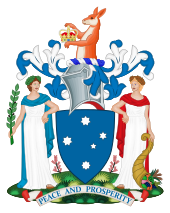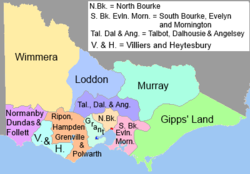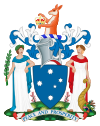Victorian Legislative Council
Legislative Council | |
|---|---|
| 59th Parliament | |
 | |
| Type | |
| Type | Upper house of the Parliament of Victoria |
| History | |
| Founded | 1851 |
| Leadership | |
Nazih Elasmar, Labor since 18 June 2020 | |
Deputy President | Wendy Lovell, Liberal since 19 December 2018 |
Leader of the Government | Jaclyn Symes, Labor since March 2020 |
Deputy Leader of the Government | Gayle Tierney, Labor since September 2020 |
Government Whip | |
| Structure | |
| Seats | 40 |
 | |
Political groups | Government (17) Labor (17) Opposition (11) Justice (2) Liberal Democratic (2) Animal Justice (1) Greens (1) Reason (1) Shooters, Fishers, Farmers (1) Sustainable Australia (1) Transport Matters (1) Independent (2)[a] |
Length of term | 4 years |
| Elections | |
Voting system | Single transferable vote with group voting tickets |
Last election | 24 November 2018 |
Next election | 26 November 2022 |
| Meeting place | |
 | |
| Legislative Council Chamber, Parliament House, Melbourne, Victoria, Australia | |
| Website | |
| Vic Legislative Council | |
The Victorian Legislative Council (VLC) is the upper house of the bicameral Parliament of Victoria, Australia, the lower house being the Legislative Assembly. Both houses sit at Parliament House in Spring Street, Melbourne. The Legislative Council serves as a house of review, in a similar fashion to its federal counterpart, the Australian Senate. Although, it is possible for legislation to be first introduced in the Council, most bills receive their first hearing in the Legislative Assembly.
The presiding officer of the chamber is the President of the Legislative Council. The Council presently comprises 40 members serving four-year terms from eight electoral regions each with five members. With each region electing 5 members using the single transferable vote, the quota in each region for election, after distribution of preferences, is 16.7% (one-sixth). Ballot papers for elections for the Legislative Council have above and below the line voting. Voting above the line requires only a '1' being placed in one box, and group voting tickets voting has applied since 1988.[1] Semi-optional voting is available if a voter votes below the line.
History[]
First Legislative Council[]

The separate colony of Victoria was proclaimed on 1 July 1851 and writs for the election of the first Legislative Council were issued at the same time for the 20 elected members.[2] The Legislative Council initially consisted of 30 members, 10 of whom were nominated by the Lieutenant-Governor and 20 were elected from 16 "electoral districts", with Melbourne electing three members, and Geelong and the county of Bourke electing two members each.[3] The electors were male British subjects over the age of 21 years, who owned freehold valued at £100 or a householder paying rent of £10 per year,[3] both very large sums at the time. Members of the Legislative Council were unpaid, further restricting participation of those without independent means. It took some time before the Legislative Council was elected and ready to sit.[4] The Legislative Council met for the first time in November 1851 at St Patrick's Hall, which had been built in 1847 in Bourke Street, Melbourne.[5] The Legislative Council sat there until the opening of the Parliament House in 1856. James Frederick Palmer was the presiding officer of the Council, then called speaker.
The Legislative Council was expanded in 1853 to 18 nominees and 36 elected members.[6] A further expansion of the Council occurred in 1855, when 8 new members were elected from five new electorates, with one new nominee.[7] [8]
The first Legislative Council existed for five years and was responsible for at least three significant and enduring contributions to the parliamentary system of Victoria:
- it drafted the Constitution of Victoria, which provides the framework for the system of government in Victoria;
- it introduced the secret ballot. The Victorian Electoral Act 1856 introduced secret ballots on 19 March 1856,[9] an innovation at the time but now common around the world; and
- it ordered the construction of the Victorian Parliament House in Melbourne.
The new constitution was approved by the Legislative Council in March 1854 and was sent to Britain where it was passed by the United Kingdom Parliament as the Victoria Constitution Act 1855, received Royal Assent on 16 July 1855 and was proclaimed in Victoria on 23 November 1855.[10][11] The Constitution established a Westminster-style system of responsible government that continues in Victoria today.[12]
Second Legislative Council[]

The new Constitution came into effect in 1856. It created a bicameral Parliament of Victoria, with the Legislative Assembly being the lower house and the Council being the upper house. The Council consisted of 30 members, with five members being elected from each of the six provinces.[13] The Parliament of Victoria first met on 21 November 1856 at the almost completed main sections of Parliament House. James Frederick Palmer was elected first President of the Council.
The Legislative Council was later elected from a varying number of provinces. In 1882, several new provinces were created while Central and Eastern were abolished.[14] In 1904, more provinces were created[15] and two members (MLCs) represented each province. The terms for members were two Assembly terms, and one member was elected in rotation at each election, by majority-preferential (AV) vote. Until 1950, the Legislative Council was elected on a restricted property-based franchise and always had a conservative majority.
Until 1958, elections for the Legislative Council were not held in conjunction with those for the Legislative Assembly, but starting at the 1961 election they have been held at the same time. Prior to the 2006 election, the Legislative Council consisted of 44 members elected for two terms of the Legislative Assembly from 22 two-member provinces. Half the members were elected at each election on a rotation basis. This old system tended to favour the Liberal Party and the National Party (often in Coalition) over the Labor Party and other parties;[16][17] as the Liberal party's support was more evenly spread across the state, compared to Labor's wasted votes in already safe provinces.[18] This resulted in many instances of a Labor government being faced with an opposition-controlled Council – a rare occurrence elsewhere in Australia.
2003 reforms[]


The system changed for the 2006 Victorian election, as a result of major reforms passed by the Labor government, led by Steve Bracks, in 2003.[19] Under the new system the State is divided into eight regions each of which returns five members, who serve terms linked to the Legislative Assembly, which has fixed four-year terms unless earlier dissolved in exceptional circumstances.
Each region consists of 11 contiguous Legislative Assembly electoral districts with about 420,000 electors. Five regions are metropolitan (Eastern Metropolitan, Northern Metropolitan, South Eastern Metropolitan, Southern Metropolitan, and Western Metropolitan) and three are non-urban regions (Eastern Victoria, Northern Victoria and Western Victoria).
Since 2006, members have been elected using the single transferable vote system of proportional representation. With each region electing five members, the quota for a seat in each region, after distribution of preferences, is 16.7% (one-sixth), resulting in an increase in the number of minor parties represented in the Legislative Council.
At the same time, the Council's ability to block supply was removed.

Composition[]
Since the 2006 Victorian state election, the Legislative Council has had 40 members serving four-year terms, elected from eight electoral regions, each returning five members.
Prior to the 2006 election, the Legislative Council consisted of 44 members elected for two terms of the Legislative Assembly from 22 two-member provinces. Half the members were elected at each election on a rotation basis. The number of members was increased to 44 from 36 in 1976 and from 34 in 1967.
Property qualifications for voting in the Legislative Council were abolished for the 1952 Legislative Council election, increasing the number of eligible voters from 0.5 million in 1949 to 1.4 million in 1952, and resulting in a large increase in the number of Labor MLCs. However, Labor achieved a majority in the Council only at the 1985 and the 2002 elections.
Current distribution of seats[]
The composition of the Council following the 2018 Victorian state election is:
Results[]
|
Distribution by region[] | |||||||||||||||||||||||||||||||||||||||||||||||||||||||||||
See also[]
- List of Victorian Legislative Council appointments
- 2018 Victorian state election
- 2022 Victorian state election
Notes[]
- ^ Current independent MLCs: Catherine Cumming (Western Metropolitan) and Adem Somyurek (South Eastern Metropolitan)
References[]
- ^ http://www.austlii.edu.au/au/legis/vic/bill/crb1988520.pdf
- ^ "Anniversary of the Week". The Argus (Melbourne, Vic. : 1848 – 1956). Melbourne, Vic.: National Library of Australia. 4 July 1930. p. 2 Supplement: Saturday Camera Supplement. Retrieved 26 January 2012.
- ^ a b "Victorian Electoral Act" (PDF). New South Wales Government. 1851. Retrieved 30 July 2014.
- ^ A City Lost and Found
- ^ Australian Dictionary of Biography: Jackson, Samuel (1807–1876)
- ^ Sweetman, p.108
- ^ Sweetman, p.110
- ^ "An Act to further alter "The Victoria Electoral Act of 1851" and to increase the Number of Members of the Legislative Council of Victoria" (PDF). 1855. Retrieved 5 June 2013.
- ^ Payment of Members Act 1870 (Vic)
- ^ "Victoria Constitution Act 1855" (PDF). Retrieved 5 May 2013.
- ^ "Altering Victoria's Constitution". Fact Sheet D3: Altering Victoria's Constitution. Parliament of Victoria. October 2010. Retrieved 5 March 2011.
- ^ "Victoria Constitution Act 1855". An Act to enable Her Majesty to assent to a Bill, as amended, of the Legislature of Victoria, to establish a Constitution in and for the Colony of Victoria. Parliament of the United Kingdom. 1855. Archived from the original on 12 March 2011. Retrieved 5 March 2011.
- ^ Edward Sweetman (1920). Constitutional Development of Victoria, 1851-6. Whitcombe & Tombs Limited. p. 183. Retrieved 5 June 2013.
- ^ Victoria Parliamentary Debates (Hansard), Session 1882 (PDF). Vol. 41. Melb.: John Ferres. 1883. p. 2670.
- ^ Victoria Parliamentary Debates (Hansard), Session 1904 (PDF). Vol. 107. Melb.: R. S. Brain. 1905.
- ^ "Victoria's unexpected minority". Inside Story. 3 September 2010. Retrieved 16 November 2020.
[...] before the 2002 election the Labor Party had enjoyed a majority in the Legislative Council for a grand total of three months (in 1985),
- ^ "Will Bracks live to regret this reform?". The Age. 15 July 2005. Retrieved 16 November 2020.
Through the 1980s, Labor actually managed to win a few state elections on the trot - but still without control of the upper house, except in 1985 when bizarre circumstances conspired to give a bare majority to Labor for a few short weeks, before normal service was resumed.
- ^ Rodan, Paul. "Not quite as expected: Victorian Labor and the Legislative Council 2010" (PDF). Australasian Study of Parliament Group. Autumn/Winter 2012 Vol 27.1.
While earlier malapportionment had given way to a version of ‘one-vote-one value’ (with a ten per cent tolerance), the distinctive population distribution of metropolitan Melbourne continued to disadvantage the ALP as it stored up majorities in safe western and northern metropolitan provinces while losing to the Liberals where it mattered most. [...] the Liberals, due to the geographical dispersal of party support in the Melbourne metropolitan area, could secure upper house majorities even when they polled far fewer votes than the ALP, as in the period of the John Cain (junior) government, elected in 1982.
- ^ Constitution (Parliamentary Reform) Act 2003
Further reading[]
- Strangio, Paul (1976). "Labor and reform of the Victorian Legislative Council, 1950-2003". Labour History. 86 (86): 33–52. JSTOR 27515966.
- Griffith, Gareth; Srinivasan, Sharath (2001). State Upper Houses in Australia (PDF). New South Wales Parliamentary Library Service.
External links[]
- Legislative Council - Parliament of Victoria
- Australia's Upper Houses - ABC Rear Vision A podcast about the development of Australia's upper houses into STV proportional representation elected chambers.
- Victorian Legislative Council
- Parliament of Victoria
- State upper houses in Australia
- 1851 establishments in Australia

